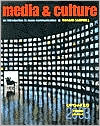Media and Culture
Search in google:
The #1 introduction to mass communication, Media & Culture goes beyond the basic facts and presents students with a critical and cultural perspective on the media. A unique five-step process encourages media literacy and focuses on the reciprocal relationship between the mass media and our shared culture, helping students to become active participants in the media. The current examples, compelling storytelling, and cutting-edge new design also help to keep students engaged. Now, this groundbreaking new edition has been revised from top to bottom making it a better learning tool than ever before.
Part 1: Mass Media and the Cultural Landscape Chapter 1: Mass Communication: A Critical Approach Culture and the Evolution of Mass Communication Oral and Written Eras in Communication The Print Revolution The Electronic and Digital Eras The Age of Convergence Mass Media and the Process of Communication The Evolution of a New Mass Medium The Linear Model of Mass Communication A Cultural Approach to Mass Communication Stories — the Foundation of Mass Communication The Power of Media in Everyday Life Surveying Tthe Cultural Landscape Culture as a Skyscraper Culture as a Map Cultural Values of the Modern Period Shifting Values in Postmodern Culture Critiquing Media And Culture Media Literacy and the Critical Process Benefits of a Critical Perspective Extended Case Study: Video Games and Storytelling Chapter 2: The Internet and New Technologies: The Media Converge The Evolution of the Internet The Birth of the Internet The Net Widens Web 1.0: The World Begins to Browse The Commercial Structure of the Web The Internet Today: Web 2.0 Instant Messaging Blogs Wiki Web Sites Social Networking Sites Massively Multiplayer Online Role-Playing Games (MMORPG) Web 3.0 Ownership Issues on the Internet Dividing up the Web Advertising on the Internet Alternative Voices Security, Appropriateness, and Access Security: The Challenge to KeepPersonal Information Private Appropriateness: What Should Be Online? Access: The Fight to Prevent a Digital Divide The Internet and Democracy Part 2: Sounds and Images Chapter 3: Sound Recording and Popular Music The Development of Sound Recording From Cylinders to Disks: Sound Recording Becomes a Mass Medium From Phonographs to CDs: Analog Goes Digital From MP3s to the Future: Recordings in the Internet Age The Rocky Relationship between Records and Radio U.S. Popular Music and the Formation of Rock The Rise of Pop Music Rock and Roll Is Here to Stay Rock Muddies the Waters Battles in Rock and Roll A Changing Industry: Reformations in Popular Music The British Are Coming! Motor City Music: Detroit Gives America Soul Folk and Psychedelic Music Reflect the Times Punk, Grunge, and Alternative Respond to Mainstream Rock Hip-Hop Redraws Musical Lines The Business of Sound Recording Music Labels Influence the Industry Making, Selling, and Profiting from Music Alternative Voices Sound Recording, Free Expression, and Democracy Chapter 4: Popular Radio and the Origins of Broadcasting Early Technology and the Development of Radio Maxwell and Hertz Discover Radio Waves Marconi and the Inventors of Wireless Telegraphy Wireless Telephony: De Forest and Fessenden Regulating a New Medium The Evolution of Radio The RCA Partnership Unravels Sarnoff and NBC: Building the "Blue" and "Red" Networks Government Scrutiny Ends RCA-NBC Monopoly CBS and Paley: Challenging NBC Bringing Order to Chaos with the Radio Act of 1927 The Golden Age of Radio Radio Reinvents Itself Transistors Make Radio Portable The FM Revolution and Edwin Armstrong The Rise of Format and Top 40 Radio Resisting the Top 40 The Sounds of Commercial Radio Format Specialization Nonprofit Radio and NPR Radio Goes Digital The Economics of Broadcast Radio Local and National Advertising Manipulating Playlists with Payola Radio Ownership: From Diversity to Consolidation Alternative Voices Radio and the Democracy of the Airwaves Chapter 5: Television and the Power of Visual Culture The Origins and Development of Television Early Innovations in TV Technology Controlling Content — TV Grows Up The Quiz-Show Scandals Diminish the Promise of TV Major Programming Trends TV Information: Our Daily News Culture TV Entertainment: Our Comic Culture TV Entertainment: Our Dramatic Culture Other Enduring Trends and Reality TV The Rise and Fall of Public Television The Decline of the Networks New Technologies Reduce Network Control Government Regulations Temporarily Restrict Network Control Emerging Networks Target Youth and Minority Markets Digital Technology Changes Our Experience of Television The Economics of Television Prime-Time Production Prime-Time Distribution Syndication Keeps Shows Going and Going... Measuring Television Viewing Alternative Voices Television, Culture, and Democracy Chapter 6: Cable: A Wired versus Wireless World Technology and the Development of Cable CATV — Community Antenna Television The Wires and Satellites behind Cable Television Cable Threatens Broadcasting Balancing Cable’s Growth against Broadcasters’ Interests Franchising Frenzy The Telecommunications Act of 1996 Cable Comes of Age Cable Targets Niche Audiences Basic Cable Services Premium Cable Services Challenges to Cable: DBS and Cell Phones DBS: Cable without Wires Cell Phones, Mobile Video, and WiMax The Major Cable and DBS Corporations The Effects of Consolidation Alternative Voices Democracy and Cable in a Wired / Wireless World Chapter 7: Movies and the Impact of Images Early Technology and the Evolution of Movies The Development of Film The Introduction of Narrative The Arrival of Nickelodeons The Rise Of The Hollywood Studio System Production Distribution Exhibition The Studio System’s Golden Age Hollywood Narrative and the Silent Era The Introduction of Sound The Development of the Hollywood Style Outside the Hollywood System The Transformation of the Studio System The Hollywood Ten The Paramount Decision Moving to the Suburbs Television Changes Hollywood Hollywood Adapts to Home Entertainment The Economics of the Movie Business Production, Distribution, and Exhibition Today The Major Studio Players Movies Adjust to the Digital Age Alternative Voices Popular Movies And Democracy Part 3: Words and Pictures Chapter 8: Newspapers: The Rise and Decline of Modern Journalism The Evolution of American Newspapers Colonial Newspapers and the Partisan Press The Penny Press Era: Newspapers Become Mass Media The Age of Yellow Journalism: Sensationalism and Investigation Competing Models of Modern Print Journalism "Objectivity" in Modern Journalism Interpretive Journalism Literary Forms of Journalism Contemporary Journalism in the TV and Internet Age Categorizing News and U.S. Newspapers Consensus vs. Conflict: Newspapers Play Different Roles Ethnic, Minority, and Oppositional Newspapers Newspaper Operations Challenges Facing Newspapers Readership Declines Only in U.S. Joint Operating Agreements Combat Declining Competition Newspaper Chains Consolidate Ownership Newspapers Go Digital to Survive Blogs Challenge Newspapers’ Authority Online Alternative Voices Newspapers and Democracy Chapter 9: Magazines in the Age of Specialization The Early History of Magazines The First Magazines Magazines in Colonial America U. S. Magazines in the 19th Century National, Women's, and Illustrated Magazines The Development of Modern American Magazines Social Reform and the Muckrakers The Rise of General-Interest Magazines The Fall of General-Interest Magazines The Domination of Specialization Men’s and Women’s Magazines Sports, Entertainment, and Leisure Magazines Magazines for the Ages Elite Magazines Minority-Targeted Magazines Supermarket Tabloids Online Magazines and Media Convergence The Organization and Economics of Magazines Magazine Departments and Duties Major Magazine Chains Alternative Voices Magazines in a Democratic Society Chapter 10: Books and the Power of Print The History of Books From Papyrus to Paperbacks The Development of Manuscript Culture The Innovations of Block Printing and Movable Type The Gutenberg Revolution: The Invention of the Printing Press The Birth of Publishing in the United States Modern Publishing and the Book Industry The Formation of Publishing Houses Types of Books Trends and Issues in Book Publishing Influences of Television and Film Audio Books E-books Preserving and Digitizing Books Censorship and Banned Books Ownership Patterns The Structure of Book Publishing Selling Books: Stores, Clubs, and Mail Order Alternative Voices Books and the Future of Democracy Part 4: The Business of Mass Media Chapter 11: Advertising and Commercial Culture Early Developments in American Advertising The First Advertising Agencies Advertising in the 1800s Promoting Social Change and Dictating Values Early Ad Regulation The Shape of U.S. Advertising Today The Influence of Visual Design Types of Advertising Agencies The Structure of Ad Agencies Business Trends in Internet Advertising Persuasive Techniques in Contemporary Advertising Conventional Persuasive Strategies The Association Principle Advertising as Myth Product Placement Commercial Speech and Regulating Advertising Critical Issues in Advertising Watching over Advertising Alternative Voices Advertising, Politics, and Democracy Advertising’s Role in Politics The Future of Advertising Chapter 12: Public Relations and Framing the Message Early Developments in Public Relations P. T. Barnum and Buffalo Bill Big Business and Press Agents The Birth of Modern Public Relations The Practice of Public Relations Approaches to Organized Public Relations Performing Public Relations Public Relations during a Crisis Tensions between Public Relations and the Press Elements of Professional Friction Shaping the Image of PR Alternative Voices Public Relations and Democracy Chapter 13: Media Economics and the Global Marketplace Analyzing the Media Economy The Structure of the Media Industry The Performance of Media Organizations The Internet Changes the Game The Transition to an Information Economy Deregulation Trumps Regulation Media Powerhouses: Consolidation, Partnerships, and Mergers Business Tendencies in Media Industries Economics, Hegemony, and Storytelling Specialization and Global Markets The Rise of Specialization and Synergy Disney: A Postmodern Media Conglomerate Global Audiences Expand Media Markets Social Issues in Media Economics The Limits of Antitrust Laws The Fallout From a Free Market Cultural Imperialism The Media Marketplace and Democracy The Effects of Media Consolidation on Democracy The Media Reform Movement Part 5: Democratic Expression and the Mass Media Chapter 14: The Culture of Journalism: Values, Ethics, and Democracy Modern Journalism in the Information Age What Is News? Values in American Journalism Ethics and the News Media Ethical Predicaments Resolving Ethical Problems Reporting Rituals and the Legacy of Print Journalism Focusing on the Present Relying on Experts Balancing Story Conflict Acting as Adversaries Journalism in the Age of TV and the Internet Differences between Print and TV News The Internet Enhances and Challenges Journalism The Power of Visual Language Alternative Models: Public Journalism and Fake News The Public Journalism Movement Fake News and Satiric Journalism Democracy and Reimagining Journalism’s Role Social Responsibility Deliberative Democracy Chapter 15: Media Effects and Cultural Approaches to Research Early Media Research Methods Propaganda Analysis Public Opinion Research Social Psychology Studies Marketing Research Research on Media Effects Early Explanations of Media Effects Conducting Media Effects Research Contemporary Media Effects Theories Evaluating Research on Media Effects Cultural Approaches to Media Research Early Developments in Cultural Studies Research Contemporary Cultural Studies Theories Evaluating Cultural Studies Research Media Research and Democracy Chapter 16: Legal Controls and Freedom of Expression Origins of Free Expression and a Free Press Models of Expression The First Amendment of the U.S. Constitution Censorship as Prior Restraint Unprotected Forms of Expression First Amendment versus Sixth Amendment Film and the First Amendment Social and Political Pressure on the Movies Self-Regulation in the Movie Industry The MPAA Ratings System Expression in the Media: Print, Broadcast, and Online The FCC Regulates Broadcasting Dirty Words, Indecent Speech, and Hefty Fines Political Broadcasts and Equal Opportunity The Demise of the Fairness Doctrine Communication Policy and the Internet The First Amendment and Democracy Extended Case Study: Analyzing Coverage of the Economic Crisis








